Learn how to navigate and understand your microbiome test results, where to find every report (with links), what each section is about, and all about our new lactose, gluten and inflammation reports.
Whether you’re considering buying the Atlas Microbiome Test or you already have your test results, we want you to get the most out of them. With this in mind, this article will help you to navigate and understand your microbiome test results in our new display. This is the definitive introduction to your account from start to finish:
- Navigating your microbiome test results
- An overview of the results and scores
- General recommendations: actionable and to the point
- Get the Atlas Health app
- Free Nutritionist consultation with every kit
- NEW! Your anti-inflammatory report
- NEW! Your lactose metabolism report
- NEW! Your gluten metabolism report
- How to read your disease protection results
- Get new insights with the health survey
- Scientific references and research
- Find stuff quickly using data sources
- Learn more about everything in the blog
Understand and navigate the results dashboard
Your Atlas Microbiome Test results are displayed in a dashboard that you can access online through your browser or by downloading the Atlas Health app for iOS and Android.
Register your kit barcode
If you’ve just bought your test, then the first step is registering your kit. To do so, create an account. On the main page, scroll down, and it will invite you to register your kit’s barcode. The barcode is located on the test tube (see below).
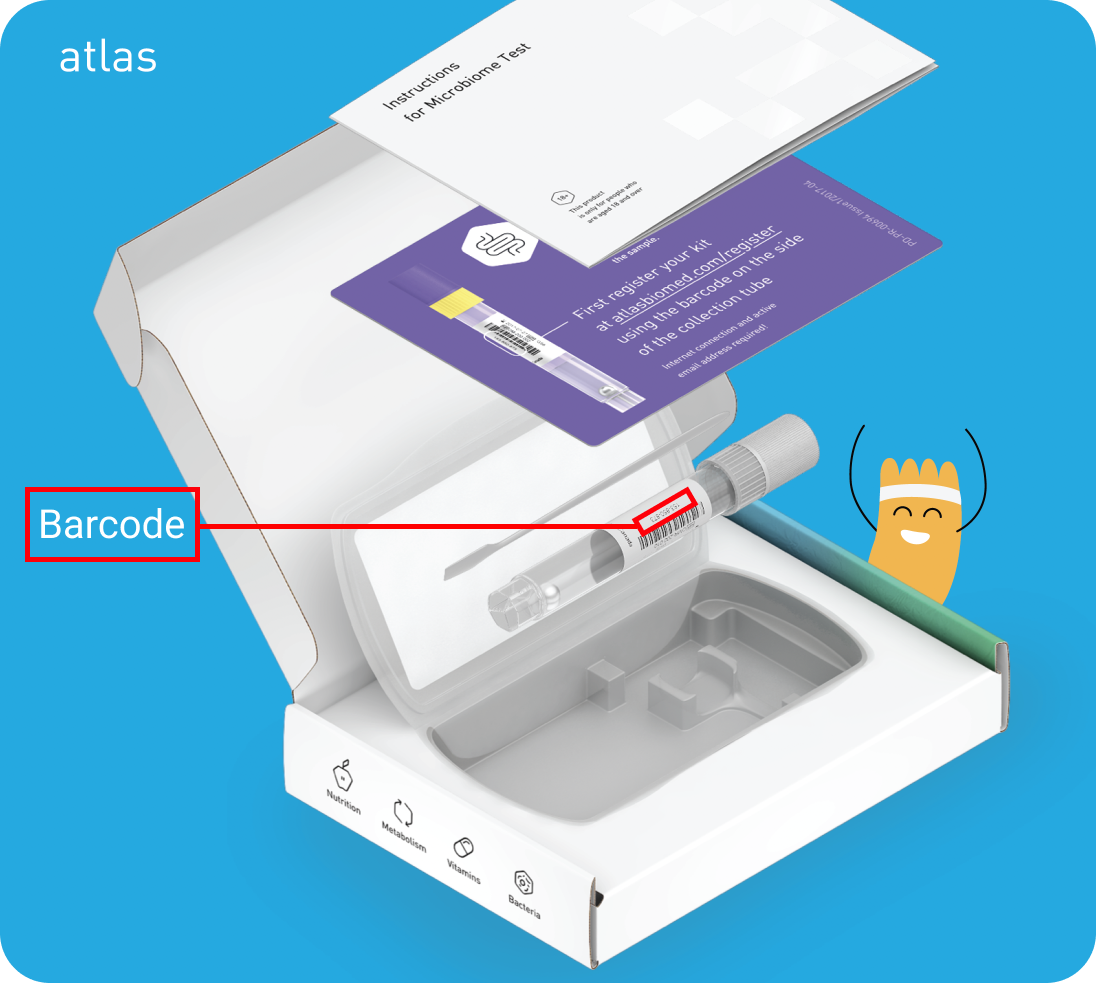
If you send back your sample without registering the barcode, we will not be able to identify the account where the results need to be uploaded. This can significantly delay the release of your results.
How to access your microbiome results
Go to our main page: https://atlasbiomed.com and click on the circular white icon in the top right-hand corner. This will take you to the login page, enter your details and you’ll access the dashboard.
You will recognise it by the outline of a human head and shoulders. If you stay logged in, the icon will be blue. If you upload a profile pic, it will instead appear here instead.
☝DNA & microbiome users: if you’ve taken both tests, scroll down on the left hand side menu until you see data sources and select the first icon. It will allow you access only your microbiome results.
Atlas Microbiome Test results overview
The dashboard can help you access every section of your results. They are organised into "reports" that unite all the findings about one subject onto one page.
| Report | What you'll learn |
| Disease protection | See how well your gut microbes protect you from diabetes type 2, atherosclerosis, obesity, Crohn’s and ulcerative colitis |
| Read more: The gut microbiome protects you from 5 serious diseases | |
| Microbiome diversity | This part assesses the diversity of bacteria types living in your gut, a key parameter for human health |
| Read more: How do gut bacteria protect your health? | |
| Butyrate synthesis potential | Discover your bacteria’s butyrate production potential compared to the population average and how it supports your health |
| Read more: What is butyrate and why you should care | |
| Lactose metabolism | Find out how well your gut bacteria break down lactose (milk sugar) and how this might contribute to digestive symptoms like abdominal pain, bloating, or diarrhoea |
| Gluten metabolism | Discover how your microbiome breaks down gluten, a protein found in wheat, rye and barley, and how this is associated with gluten sensitivity |
| Inflammation report | Gut bacteria can both stimulate and suppress inflammation: find out your balance of anti-inflammatory and pro-inflammatory microbes and how to improve it |
| Read more: What is chronic inflammation, and why is it bad? | |
| Microbiome enterotype | Find out which of 3 main gut microbial ecosystems your bacteria belong to and what it says about your diet |
| Read more: What are microbiome enterotypes? | |
| Probiotics & beneficial bacteria | Discover how you compare to the population, what beneficial bacteria were identified (%) and what it means for your wellbeing |
| Read more: articles about probiotic bacteria and supplements | |
| Dietary fibre metabolism | This part assesses how well your gut microbes break down different dietary fibres found in food |
| Vitamin synthesis | Gut microbes produce 8 different vitamins: see if your production potential is below-average, normal, or above-average for each one |
| Nutrition traits | This report covers health insights and a summary of your gut microbiome's vitamin synthesis report |
| Microbiome ancestry | Find out with which nationality, tribe or ethnic group your microbes have the most in common |
Understand your microbiome scores
The dashboard summarises your results. Microbiome diversity and butyrate production potential are rated from 1–10, as is your gluten/lactose metabolism and your inflammation potential.
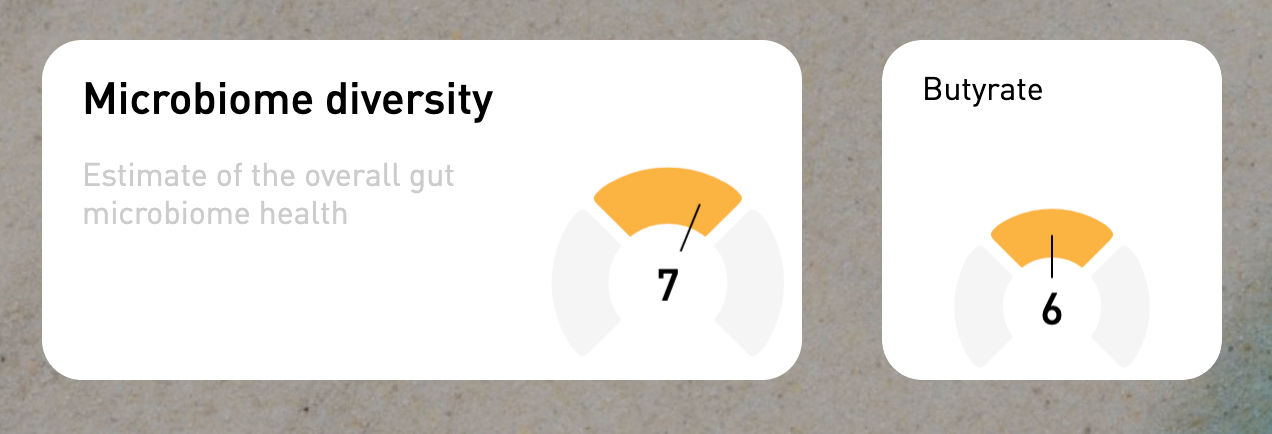
1 is considered very low/weak/below-average. It means that your microbiome does not perform its functions sufficiently for you to receive the health protection your body deserves.
10 is excellent/significantly above-average based on current science: your microbiome performs its functions extremely well and provides you with many potential health-protective benefits.
Understand the colour-coding
Every section of your results is helpfully colour-coded:

| RED | Your rating is below-average, follow your recommendations to improve your health outcomes and increase your disease protection. |
| ORANGE | Your rating is average, but it could be better. Follow your recommendations to improve your results and health outcomes. |
| GREEN | Excellent, your rating is above-average. Remember, the microbiome is very responsive to change, so follow your personal recommendations. |
General recommendations: simple, actionable guidance
There are a lot of different reports on the dashboard, and we understand that sometimes you just want quick health insights that are to the point. We have you covered, as the dashboard now has a list of general recommendations which link to the most important practical insights from your test results.

For example, suppose your microbiome is lacking bacteria that produce butyrate, an essential short-chain fatty acid that can reduce your risk of low-grade inflammation and may even help grow new brain cells in old age. In that case, there will be a recommendation on your dashboard to eat more foods that feed beneficial bacteria, which in turn, encourage butyrate synthesis. Better still, this recommendation then links to a list of foods that can help increase these levels and scientific papers explaining why. It’s that easy.
Likewise, if you have a low B2 vitamin synthesis level, for example, your general recommendations will include a prompt to eat more foods that will promote beneficial bacteria and produce this. Neat, huh?
Download the Atlas Health app
View your microbiome test results on the go with the Atlas health app, available for both iOS and Android. You can access your food recommendations whilst shopping and create food photo diary to track your meals by snapping a picture wherever you ar. The health app also rates your plate on how well it nourishes the good bacteria in your gut.
This is a quick and effective method of tracking dietary changes and optimising your health. Don’t just take our word for it: according to a 2020 study, food photo diaries are more precise than both manually tracking dietary changes or using electronic sensors, and whilst we don’t like to toot our own horn, our photo food tracking feature also won first place at NutraIngredients Awards 2021!
Free nutritionist consultation with every test
It’s important to us that you fully understand your results and know how to act on this information, so with this in mind, we’re offering a free nutrition counselling session for microbiome test users.
After registering a kit and recieving your results, you will receive an email with instructions on how to book an appointment. This free counselling session combines your microbiome results and personalised nutritional advice to help you implement sustainable dietary changes for the better.
NEW! Your anti-inflammatory report

Some opportunistic bacteria produce pro-inflammatory molecules called endotoxins when they die, which trigger low-grade inflammation in the body as they enter the bloodstream.
Other bacteria, like Akkermansia and butyrate-producing microbes, can suppress inflammation by strengthening cells in the intestinal lining. By measuring the balance of pro-inflammatory and anti-inflammatory bacteria in your gut, we rate your microbiome inflammation potential out of 10. Understanding this can help you alter your microbiome to prevent low-grade inflammation, something associated with many non-infectious diseases.
In this report, you will see a list of all the data sources used to calculate your inflammation potential, namely butyrate synthesis and the amounts of pro-inflammatory and anti-inflammatory bacteria in your gut.
Additionally, the inflammation report gives you nutritional insights on how to maintain or improve your inflammation potential and optimise immune health, making it easy for you to make the necessary changes. Remember, unlike our genes, our gut microbiome is dynamic and responds to lifestyle and diet.
NEW! Your lactose metabolism report

Your microbiome test now includes a report on the lactose metabolism potential of your gut bacteria, ranked from 1-10. Wondering how your gut bacteria relate to lactose intolerance? In short, some studies have shown that increasing lactic acid bacteria in the microbial population of your gut can help improve the symptoms of mild to moderate lactose sensitivity.
This is because certain bacteria, particularly lactobacillus, can break down lactose (milk sugar) with lactase, an enzyme those with an intolerance lack. Interestingly, studies have found that galactooligosaccharides (GOS) supplements can reduce the side effects of lactose intolerance, namely cramping, stomach pain and diarrhoea. This is because GOS is a prebiotic which feeds lactobacillus. Check out these delicious prebiotic recipes for some ideas on how to get it in your diet!
The microbiome test looks at the levels of lactic acid bacteria in your stool such as lactobacillus and bifidobacteria: the fewer of these lactase-producing bacteria that are present, the lower your lactose metabolism score will be. If you lack these, your nutritional insights will give you actionable suggestions to help these milk-loving microbes move in, and that’s good for all parties involved.
NEW! Your gluten metabolism report
Gluten is a protein found in wheat, rye and barley that some individuals are intolerant to; sensitivity to gluten can lead to a range of symptoms including constipation, diarrhoea impaired concentration and poor memory. The reasons behind gluten sensitivity are not well understood, but researchers believe our microbiome can influence gluten metabolism and how it affects the human body, either soothing or exacerbating gluten intolerance.
This is because different bacteria break down gluten in different ways, with some producing chemicals that may cause an immune reaction and others producing harmless metabolites (molecules resulting from chemical reactions). By analysing the types and proportions of bacteria in your gut, we rank your microbiome’s ability to break down gluten on a scale of 1–10. It should be noted that there are genetic components to gluten intolerance also.
☝If you have wheat allergy or coeliac disease You should avoid products containing these regardless of your gut microbiome composition.
Understand the disease protection results
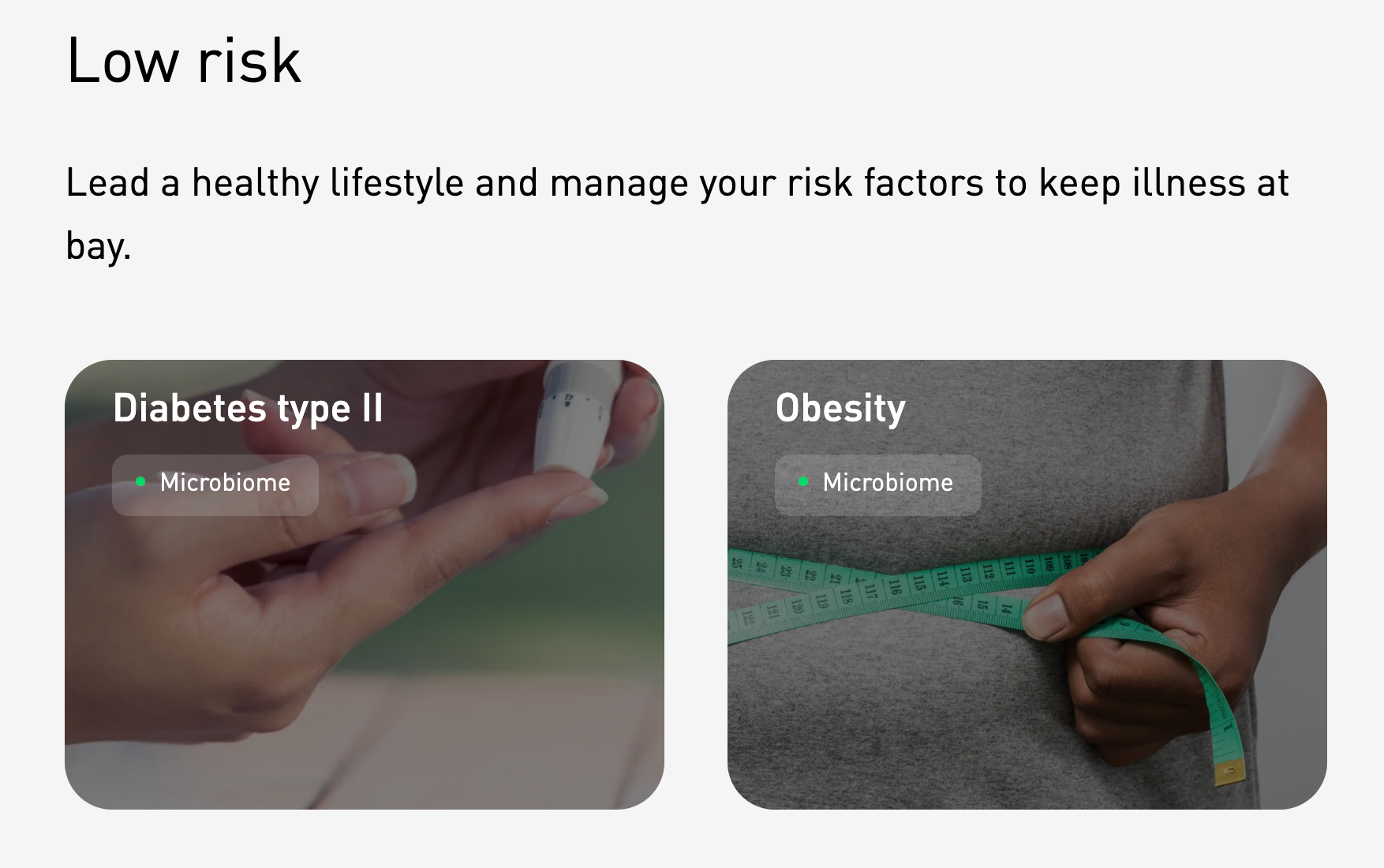
The Atlas Biomed Microbiome Test assesses the protection level conferred by your gut microbes for five diseases. Each disease has its own report page that contains the following details:
- Summary of the condition and your result
- Microbiome features associated with the disease
- A chart comparing your microbiome protection level (for repeat testing)
Disease prevalence refers to what percentage of the population is affected currently. We include details about the statistical data like sex. For ulcerative colitis (picture above), the most relevant data available only considers men. Unfortunately, there’s nothing we can do about gender and/or racial equality in studies conducted by other people.
Genetic impact will be evaluated if you take our DNA test. This page will be updated to include all the relevant data from your genetic test results and your disease profile will include risk status (DNA test & Health Survey) and protection (microbiome test).
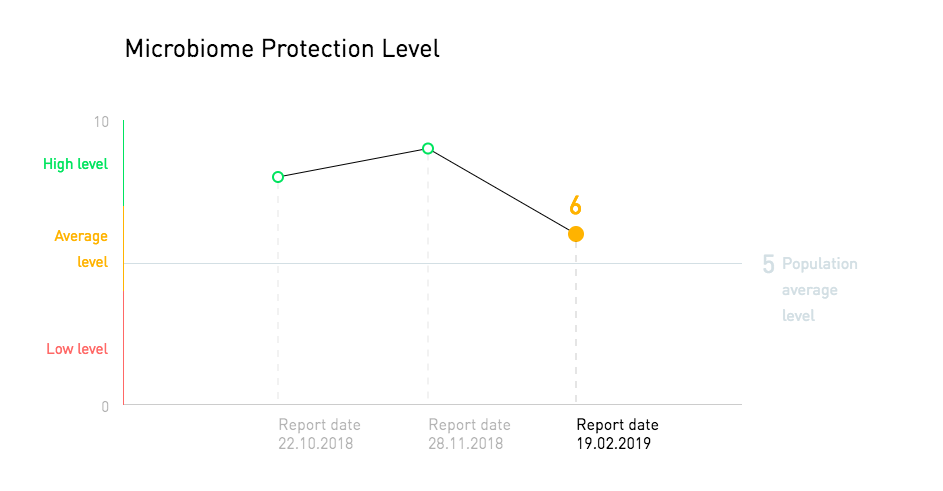
Microbiome protection rating is measured on a scale of 1 to 10. How do we calculate your score? In short, we look at the microbiomes of individuals who suffer from five non-infectious diseases, including Chrohn’s and ulcerative colitis, and compare your gut bacteria; the fewer features that individuals with these diseases share with your microbiome, the greater your level of protection from this disease will be.
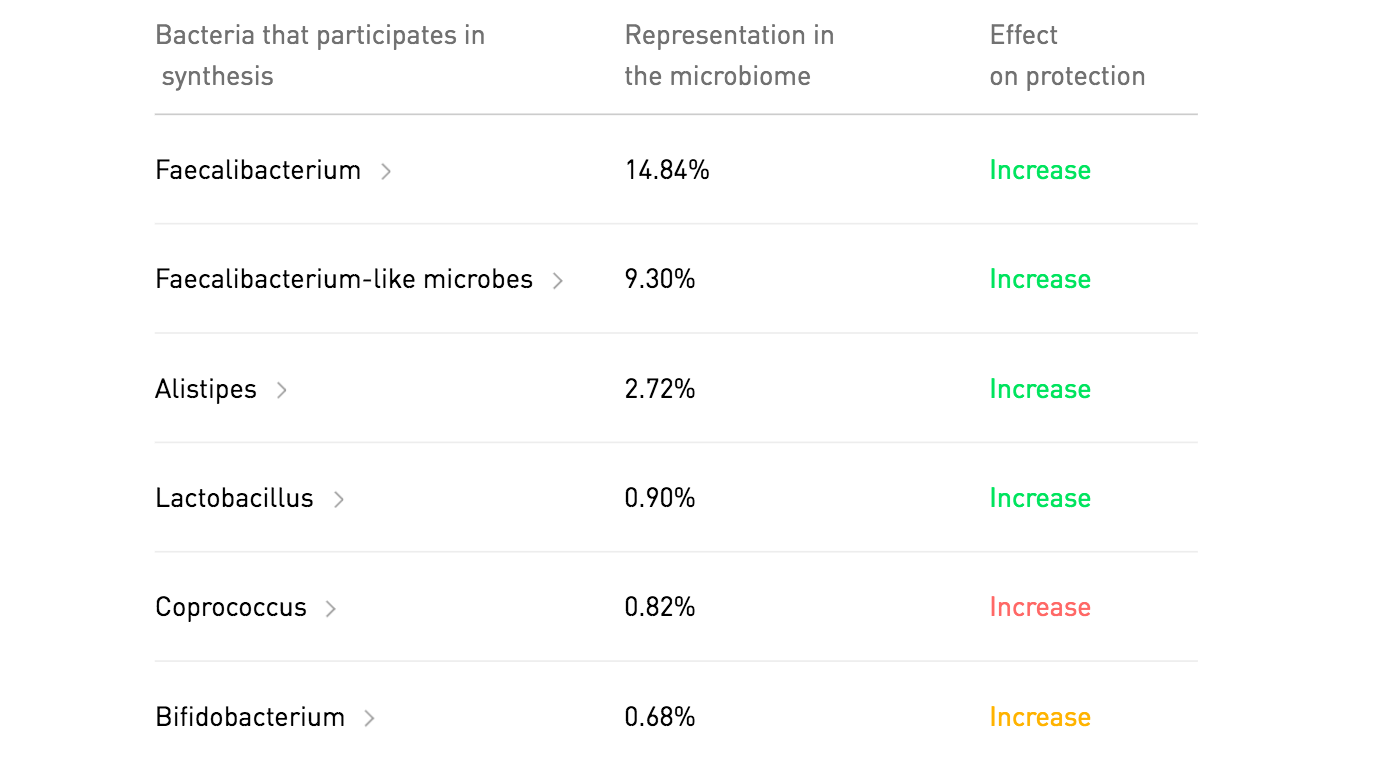
You can review the raw data that describes in detail the ratios of bacteria found in your sample and how it affects your protection level.
New insights with the health questionnaire
So you’ve bought our test, sent in your sample and read your results. But to get real bang for your buck, you need to spend about 20 minutes answering odd questions about how many tablespoons of vegetables you eat per week and whether you were born by C-section. We know the questions are weird and you’ve never measured your vegetable intake in spoons but it’s totally worth it, we promise. Mainly because health outcomes are largely influenced by environmental factors like lifestyle, sports and diet, but also family and medical history.
On top of that, we actually update our calculations using the latest science about every six months. So, chances are, there are some new questions to answer, and therefore new health insights and recommendations!
To find your health questionnaire in a jiffy, just navigate using the third icon below Data sources in the menu on the left.
☝Ready to refresh your health insights? Good, because it won’t take long if you head to your personal account right now.
Scientific references and research
We’ve included the references for every scientific paper used to generate your report. That’s because transparency is paramount in this field: you deserve to know how we came to this conclusion.
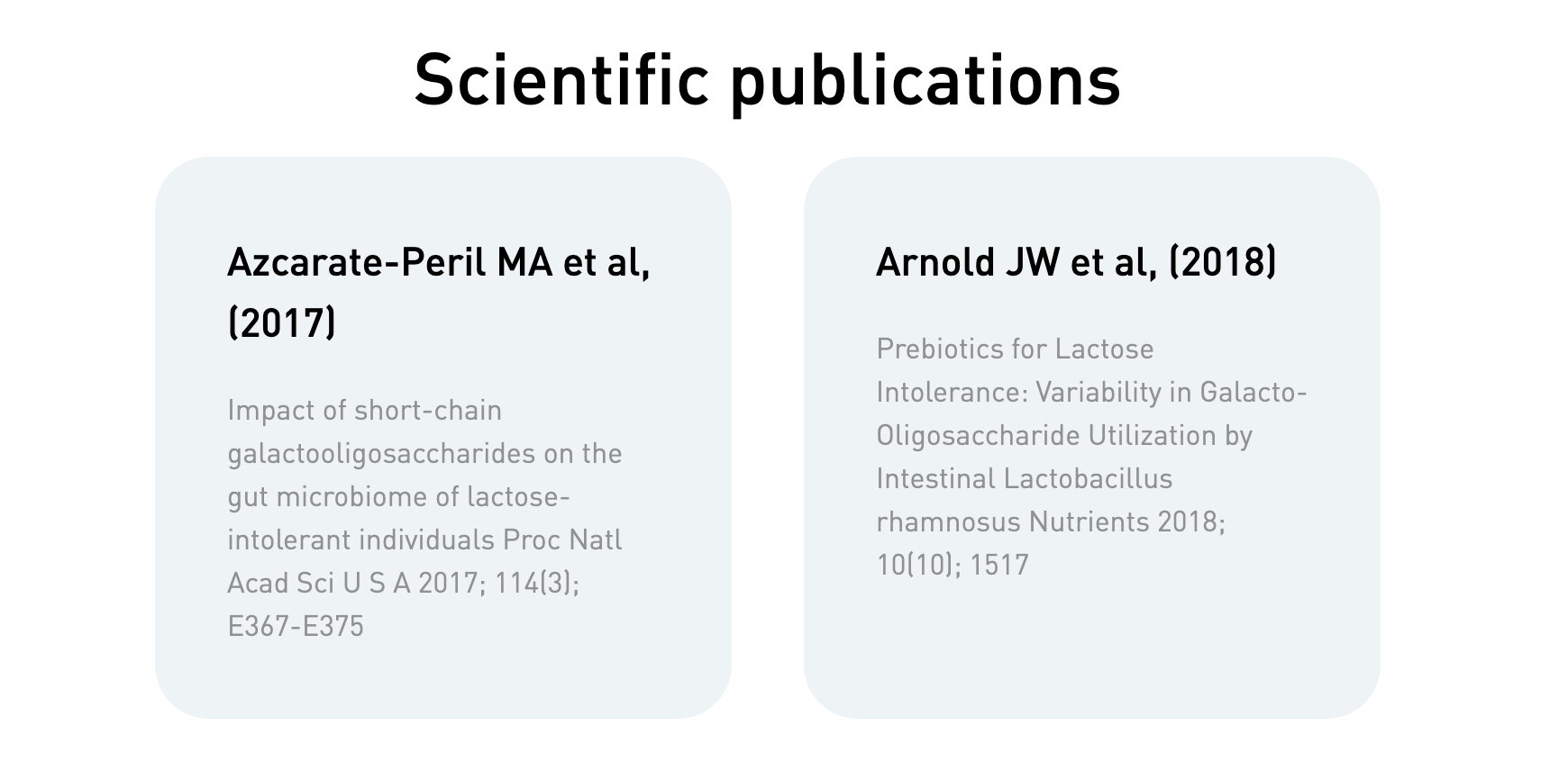
We hope that it will also allow you to explore and self-educate by directing you to the studies used to establish your results. The Atlas Biomed family includes an active research department, which regularly publishes in scientific journals.
Sometimes we invite users to participate in surveys to further research in this field, so keep an eye on your emails.
Navigate quickly with Data Sources
This is the fastest way to access a clear and concise list of all your microbiome results. Find the date of your last microbiome test, raw data and plain summary of your results in the menu on the left, at the bottom under data sources and select the first icon.
Don’t forget the blog
In addition to a team of scientists, we also have journalists investigating the microbiome with you in mind. Their job is to summarise the research in ways that you can understand and publish it on the Atlas Biomed Blog.
We don’t dilute the science with oversimplifications, rather we try to give you the tools and knowledge to cultivate your understanding of basic concepts about health, the microbiome and DNA.
☝️DISCLAIMER☝This article is for informational purposes only. It is not intended to constitute or be a substitute for professional medical advice, diagnosis, or treatment.
















